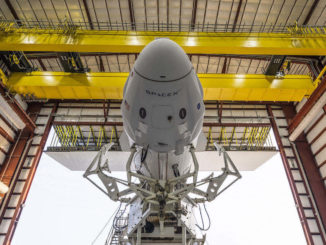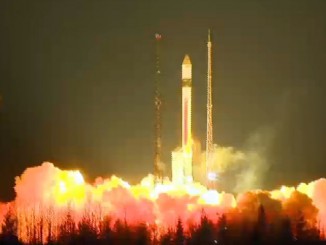
A long-delayed Russian science module was transported by train from Moscow to the Baikonur Cosmodrome in Kazakhstan earlier this month for a final series of electrical tests and outfitting before launch to the International Space Station next year.
The bus-sized Nauka research module — also known as the Multipurpose Laboratory Module, or MLM — has been in development for more than 20 years, originally as a backup for Russia’s Zarya module, the first element of the space station to launch in 1998. Russia said in 2004 that the backup to Zarya would be converted into a lab module for launch in 2007.
But delays have kept the Russian lab on the ground for years. Engineers at Energia, the prime contractor for Russia’s human spaceflight program, found flaws in the module’s propulsion system in 2013. The module was returned to Khrunichev, its manufacturer, for lengthy repairs that delayed Nauka’s launch several more years.
Nauka, which means “science” in Russian, will be the largest Russian element to join the International Space Station since the launch of the Zvezda service module in 2000. Designed to support scientific experiments, the module measures about 43 feet (13 meters) long and will weigh more than 44,000 pounds (20 metric tons) when it blasts off on top of a Russian Proton rocket from Baikonur.
The last Russian pressurized element of any size launched to the space station was the Rassvet docking module, which was delivered by a NASA space shuttle in 2010.
Roscosmos, the Russian space agency, announced in July that the Nauka module passed vacuum testing designed to check for leaks in the craft’s pressure shell, docking system and hatches. The vacuum testing also checked the readiness of the module’s propulsion and thermal control systems, according to Roscosmos.
“The Nauka module development began over 20 years ago based on the Zarya backup module – the FGB-2,” Roscosmos said in a statement. “The terms of the module readiness shifted repeatedly requiring modernization of some elements.”
Nauka departed its manufacturing facility at Khrunichev in Moscow on Aug. 11 bound for the Baikonur Cosmodrome. The module completed its rail journey Aug. 19, and technicians began unpacking the laboratory from its shipping container to prepare for a series of “complex tests,” Roscosmos said.

Energia and Khrunichev teams at Baikonur will perform quality checks on the Nauka module and commence a series of more than 750 electrical tests. Ground crews will also install external shielding, Nauka’s power-generating solar panels, and a European Robotic Arm on the outside of the lab module.
The testing and outfitting will take about nine months, setting the stage for Nauka’s launch on top of a Russian heavy-lift Proton booster in the spring or summer of 2021.
Full-scale development of the European Robotic Arm began in 1996, and the arm has been in storage more than a decade. Originally planned for launch on a NASA space shuttle, the 37-foot-long (11.3-meter) arm will join Canadian and Japanese robotic manipulators outside the space station, assisting with the movement of external payloads and helping astronauts with spacewalks.
The launch plan for the robotic arm changed, and the European Space Agency said it was ready to ship the 37-foot-long (11.3-meter) arm to Russia in 2006 for installation on the new Russian MLM science element for launch on a Proton rocket. But the robotic arm was placed in storage in Europe to await readiness of the oft-delayed Nauka module.
After launch, the Nauka module will dock with the nadir, or Earth-facing, port of the space station’s Russian Zvezda service module. That location has been occupied by the Russian Pirs docking compartment since 2001.
The Pirs module will be discarded before Nauka’s arrival using a departing Russian Progress cargo freighter, which will guide itself back into Earth’s atmosphere to burn up on re-entry with the Pirs compartment.
Email the author.
Follow Stephen Clark on Twitter: @StephenClark1.



